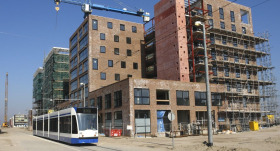- October 3rd, 2022
- 0 Comments

This editorial published by Smart Cities Dive looks at how building walkable communities with easy access to public transit could be the key to reducing our reliance on cars and achieving environmental goals.
Transportation makes up the largest share of U.S. carbon emissions, and expanding public transit will play an important role in decarbonizing the sector. More and more cities are tackling this issue with transit-oriented development, or developing residential areas with convenient access to transit. In practice, this translates to making sure daily activities – from picking up groceries to dropping kids off at school – can be managed without needing to drive, though this is a tall order for many today.
According to 2017 National Household Travel Survey data from the Federal Highway Administration, the average American commute exceeds 10 miles. So according to the article's writer, David Scorey, supportive city zoning laws and urban development initiatives are a key part of how public transit will help us make progress toward our environmental goals.
Congestion – which has become a hallmark of America's biggest cities – is bad for the environment, not to mention a burder for drivers in stop-and-go traffic and a danger to pedestrians trying to navigate cities not built to accommodate them. As such, walkability and bikeability will play a major role in this shift toward transit-oriented development. We're already seeing experiments with this approach across the globe. (Read: The 15-Minute City)
Read the complete article for more perspective on how transit-oriented development's impact on land usage can further reduce emissions, foster greener cities, advance climate and equity goals, and more.













